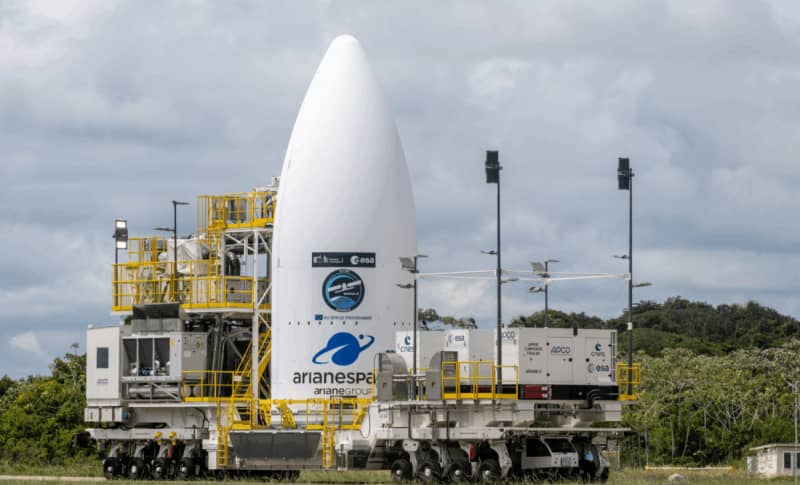
Image credit: ESA | The Daily Galaxy –Great Discoveries Channel
Europe’s Ariane 6 rocket is gearing up for its fourth-ever launch today, carrying the crucial Sentinel-1D satellite into orbit. This mission is a key step in enhancing Earth-observation capabilities, particularly for disaster response, environmental monitoring, and maritime safety. As part of the European Space Agency’s (ESA) Copernicus program, the satellite will improve global surveillance and data collection. With this launch, Europe is solidifying its position in space exploration, following up on its successful rocket test flights.
The Critical Role of Sentinel-1D in Earth Observation
Sentin…

Image credit: ESA | The Daily Galaxy –Great Discoveries Channel
Europe’s Ariane 6 rocket is gearing up for its fourth-ever launch today, carrying the crucial Sentinel-1D satellite into orbit. This mission is a key step in enhancing Earth-observation capabilities, particularly for disaster response, environmental monitoring, and maritime safety. As part of the European Space Agency’s (ESA) Copernicus program, the satellite will improve global surveillance and data collection. With this launch, Europe is solidifying its position in space exploration, following up on its successful rocket test flights.
The Critical Role of Sentinel-1D in Earth Observation
Sentinel-1D is not just another satellite in the sky; it plays a vital role in the European Space Agency’s (ESA) Copernicus Earth-observation program. With the ability to provide high-resolution radar imagery, this satellite enhances the monitoring of our planet’s surface in all conditions—whether it’s sunny, cloudy, or even at night. ESA highlights the importance of this service, explaining that it is crucial for disaster response teams, environmental agencies, maritime authorities, climate scientists, and others who rely on timely, accurate data.
The radar capabilities of Sentinel-1D are unique because they offer imagery even when weather conditions are less than ideal. Unlike optical imaging systems, which require clear skies to function, radar can “see” through clouds and even at night. This is especially important for regions that face unpredictable weather or in situations where rapid response is required, such as natural disasters or environmental monitoring.
The replacement of Sentinel-1A, which had exceeded its planned operational lifetime, comes as a timely improvement to the network of Earth-observation satellites already in orbit. Sentinel-1D, alongside its twin Sentinel-1C, will provide continuous, reliable coverage of the Earth, ensuring that critical data is always available.
A Powerful Partnership: Sentinel-1D and Sentinel-1C
The collaboration between Sentinel-1D and its predecessor, Sentinel-1C, will create a powerful network of satellites. ESA underscores that the two satellites will work in tandem to generate “timely data,” which will be invaluable to a range of users, from governments to private companies. Both satellites are equipped with advanced radar instruments, including the C-band synthetic aperture radar (SAR), which is capable of capturing high-resolution images of Earth’s surface.
This radar system is pivotal for a range of applications, including monitoring urban development, agricultural practices, and natural disasters. Furthermore, the satellites come with an Automatic Identification System (AIS) that tracks the movement of ships across the globe. This is crucial for maritime safety and helps authorities ensure that ships follow safe routes while also assisting in environmental monitoring by detecting illegal fishing or pollution.
With these technologies, the Sentinel-1 satellites provide data that is vital for decision-makers worldwide. As the world grapples with climate change and increased natural disasters, the ability to monitor and respond quickly is more important than ever. Together, Sentinel-1C and Sentinel-1D will form an essential part of the ESA’s efforts to provide accurate, actionable insights into the health of our planet.
Arianespace’s Ariane 6 Rocket: A New Era of European Space Exploration
The Ariane 6 rocket represents the future of European space exploration. With its heavy-lift capabilities, it is designed to take on a variety of payloads, from satellites likeSentinel-1D to scientific equipment and communications satellites. The Ariane 6 is the successor to the Ariane 5, which had been in service for nearly three decades before its retirement in July 2023.
Ariane 6’s inaugural flight in 2024, though marked by some technical challenges, showed that Europe’s space industry is ready to compete with the likes ofSpaceX and other global players. With its ability to launch heavier payloads at more cost-effective prices,** Ariane 6** is poised to become a central figure in the space industry, not just for European missions but also for international collaborations.
As part of Arianespace’s ambitious plans, the Ariane 6 rocket is set to play a key role in expanding Europe’s space exploration capabilities. Today’s launch of Sentinel-1D will be a pivotal moment for the program, with the rocket continuing its journey toward operational reliability and success. With multiple successful flights already under its belt, the Ariane 6 is proving itself as a capable, next-generation launch vehicle.
Enjoyed this article? Subscribe to our free newsletter for engaging stories, exclusive content, and the latest news.